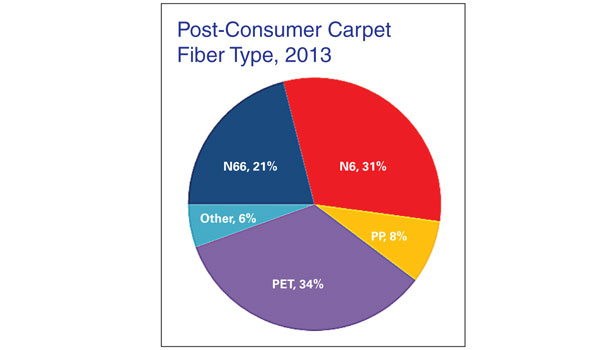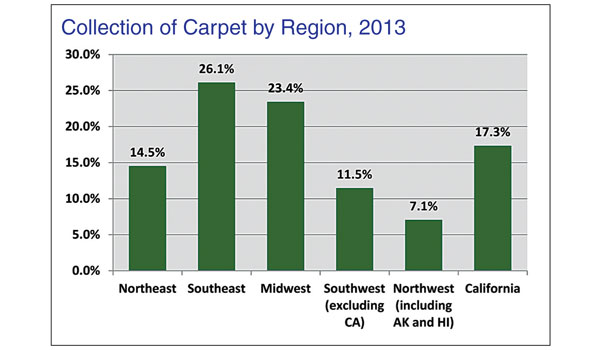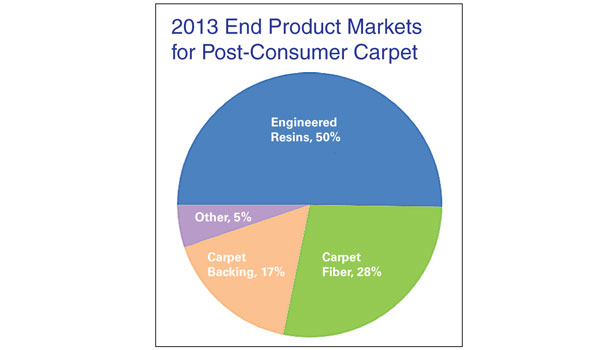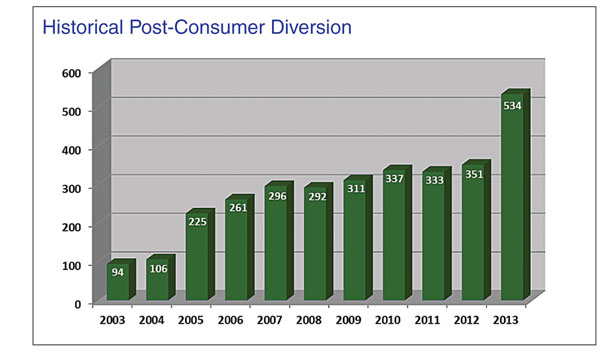CARE Report Shows Carpet Industry Recycling Product at Record Amounts

The carpet industry is recycling more fiber than ever as noted in CARE’s 12th annual report. Products such as Shaw Industries’ Impressible, which is made from its Anso nylon brand, are helping to make that happen.

As this chart clearly shows, since 2008 the stark rise in the amount of polyester (PET) carpet fiber being collected while the overall amount of nylon drops. This has made it difficult on the collection network, as there is currently no viable after markets for the PET.

While nylon, with both 6 and 6,6 counted together, still makes up the bulk of the fiber type collected at 52%, it is down from 59% in 2012. Meanwhile, polyester (PET) continued to take up more share and now represents over one-third of the fiber type collected.

Using a 2013 model by the Environmental Protection Agency to calculate greenhouse gas (GHG) equivalents, this graph represents what was saved last year based on the amount of carpet diverted from landfills.

When it comes to where post-consumer carpet is collect from, the Southeast leads at 26.1%, followed by the Midwest at 23.4%. Because of California’s recycling initiative law, AB 2398, it is counted separately and represented 17.3% of the carpet collected while the rest of the Southwest came in at 11.5%. The Northeast accounted for 14.5% and the Northwest, which includes Alaska and Hawaii, represented 7.1%.

As this chart shows, the carpet industry is recycling more post-consumer collected carpet than ever, 45%, up from 27% versus 2012. Carpet face fiber use increased to 28% from 15% in 2012, while carpet backing use increased to 17% from 12% in 2012.

Utilizing a new way to measure the amount of carpet collected, CARE said the industry diverted a record 534 million pounds of post-consumer carpet from landfills last year.







In its 12th year, the Carpet America Recovery Effort (CARE) overcame challenging hurdles which included the organization’s first formal audits; the loss of two major processors in California; the rapid escalation of polyester (PET) carpet in the marketplace recycle stream, and the resulting request by the collector/sorter entrepreneur community for help from the mills.
Despite all these challenges the carpet industry still managed to divert a record amount of product from going to the landfill in 2013—534 million pounds, or 14% of the 3.7 billion pounds of total discarded carpet. This is a 52% increase in the U.S. gross post-consumer carpet (PCC) collections from 2012 to 2013. Since CARE’s founding in 2002, this means more than 3.2 billion pounds of PCC have been diverted from landfills in the U.S.
“I believe CARE has moved boldly to try and address each challenge in a timely and productive manner,” said Bob Peoples, CARE’s executive director. “Once again CARE has experienced a dynamic year in terms of challenges and accomplishments. Our programs are growing more sophisticated and our challenges, in both California and the PET surge, have resulted in a shift to using contract talent and support in both areas as well as the launch of our new blog in 2013.”
Peoples noted while the industry diverted the most PCC in one year than it ever has, part of that has to do with a “very high” response rate from the industry concerning the survey CARE sends out to members, and a more “sophisticated approach” the organization took to get a more accurate figure. “This year we attempted to do a massed out calculation. That is to say, if we brought this much in the front door, then how do you account for everything that went out the back door?”
One of the most significant developments, he noted, was an 87% increase in PCC going back to carpet face fiber—now at 28% compared to 15% in 2012. In addition, PCC going into carpet backing represented another 17%—a 25% increase over 2012 data. “These are major accomplishments and come from significant investment in R&D and commercial implementation by CARE members.”
While nylon—both type 6 and 6,6—continued to represent the majority of fiber types collected at 52% (down from 59%) the data shows growth in polyester face fiber is significant and has placed considerable economic pressure on recyclers. To showcase this, in 2006, PET was less than 8% of face fiber shipments and last year it is estimated to be at 34%.
And, based on current trends and industry forecasts the rise of PET and fall of nylon as a face fiber will continue—namely on the residential side, which accounts for the majority of carpet sold in the first place.
CARE’s report states the trend is “alarming for two compelling reasons: The first is the extremely rapid penetration of PET in the marketplace, while the second is the forecast for PET to grow to 50% of all face fiber between 2015 and 2016. CARE launched a major effort in 2013 to deal with this crisis. However, the economics of PET make it difficult to invest in the necessary equipment and manpower to process [it] into a valuable commodity. Given the work focused on PET to date, at this juncture CARE cannot see relief from this situation before mid-2015 under the best-case scenario.”
Brendan McSheehy, CARE’s newly elected chairman, said, “The challenge in front of us is to reach a viable business framework for CARE members to accomplish PCC diversion and recovery in the face of challenges, most notably the rise of PET carpet in the collection stream.”
As a way to do this, at CARE’s annual conference in May, the organization announced the forming of a special PET committee made up of parties from mills to the collectors to help tackle the issue. The report noted, “Initial efforts on the PET challenge have focused on identifying potential markets and property and cost requirements to compete. Going forward, CARE intends to refocus work on only the highest potential outlets with the greatest chance of success.”
On the nylon side of things, the report showed a continuing shift in favor of type 6 being collected, as type 6,6 fell from 34% in 2012 to 21% in 2013, while type 6 accounting for 31% last year up from 25% the prior year.
Interestingly, the diversion and recycling/reusing of PCC used in the U.S. is staying in the U.S., as 93% of the products were processed here, with 3.5% going to China and 3.4% going to other destinations. This can be shown somewhat by the aspect that 1,078 people were employed in local communities as a result.
So where is all the carpet coming from? A breakdown by regions shows the Southeast as being the largest at 26.1%, followed by the Midwest at 23.4%. Because of California’s recycling initiative law, AB 2398, which puts an after-sale tax on carpet for the purpose of incentivizing diversion and recycling solutions, the state is counted separately. As such, California represented 17.3% of the carpet collected while the rest of the Southwest came in at 11.5%. The Northeast accounted for 14.5% while the Northwest, which includes Alaska and Hawaii, represented 7.1%.
What do all these numbers mean to the average person when it comes to sustainability and protecting the environment—beyond the aspect of being able to keep 524 million pounds of product out of U.S. landfills?
Using the Environmental Protection Agency’s (EPA) 2013 WARM model, greenhouse gas (GHG) equivalents saved was calculated to be 193.9K mTCO2E (metric tons of carbon dioxide or CO2). Or, another way of looking at it is, GHG savings being equivalent to taking 40,822 cars off the road or enough energy to power 17,692 homes for a year.
The annual GHG savings of 193.3K is also the equivalent of driving 461,678,571miles, keeping 69,500 tons of waste from being sent to the landfill or 9,939 garbage trucks worth of waste recycled instead of being land filled.
When it comes to CO2 emissions, besides the aspect of being able to power nearly 17,700 homes in a year, it represents 21,818,949 gallons of gasoline consumed, which is 2,567 tankers worth. And, in terms of amount of coal burned, it is an annual savings of 208,276,047 pounds.
“CARE’s 2013 annual survey revealed the steady evolution of the post-consumer recycling enterprise,” Peoples concluded. And, because of the changes made to how the organization calculates the amount of PCC diverted and collected, he feels the reported data in the current survey is more accurate and reflects a truer picture of the amount of carpet diverted and recycled in 2013.” He added, even though the “survey has become more sophisticated over the years in working to avoid double counting…a small 5 million pound correction was made [for this].”
Editor’s note: Besides the overall report on what the industry as a whole did in 2013, the CARE report showcases what many of its mill and fiber supplier members have done when it comes to becoming more sustainable and environmentally friendly within their own companies. For a complete look at this, see the digital edition of Floor Trends by visiting floortrendsmag.com.
Side Bar:
Leaders Behind the Numbers
CARE’s manufacturer and fiber supplier members play a key role behind the organization’s goal to divert carpet from landfills and finding valuable uses for post-consumer carpet. In addition they continue to take measures to make themselves among the more environmentally responsible companies in the country.
The following is a breakdown of what some companies have done recently in the name of sustainability:
•Aquafil USA. Headquartered in Italy, Aquafil USA’s mission is to generate sustainable closed loop nylon 6 products from waste. Since 2011, the company has operated a nylon 6 recycling plant in Ljubljana, Slovenia.
Called the Econyl Regeneration System, it is based on the sustainable chemistry of depolymerization. Here, Aquafil takes the nylon 6 contained in pre and post-consumer wastes, such as old carpets, clothing and fishing nets and regenerates it back into virgin raw material. Operating under the motto, “recycle everything possible everyday,” Aquafil’s efforts pushed its 2013 factory recycle rate to an estimated 96%.
•Interface. In 2013, Interface celebrated its 20th anniversary and made a pledge to eliminate any negative impact the company has on the planet by the year 2020. Last year the mill manufactured 4.5 million square yards of carpet tile made with its high recycled content backing, and continued to expand its usage of recycled content nylon carpet fiber made from old carpet and commercial fishing nets.
•J+J Flooring Group. This year, the company published its first Sustainable Progress Report, which gave a detailed look at the manufacturer’s entire process and its affect on the environment. The company reports reducing its water usage by more than 16% since 2010 and it has reduced the amount of waste it sends to the landfill by more than 90% since 1992.
•Milliken & Co. The Milliken Carpet Landfill Diversion Program was created as part of the company’s No Carpet to Landfill Pledge. In 2013, the company reported the program prevented 494,702 pounds of carpet from going into landfills, with a total of 685,152 pounds diverted since being established.
During 2013, Milliken also made strides to provide product transparency to the architecture and design communities. All Milliken North American standard modular carpet collections have environmental product declarations (EPDs) that identify environmental impacts over their life cycle and the company discloses the components of its commercial carpet tile products through Declare.
•The Mohawk Group. Sustainability has long been at the core of the company. Mohawk’s programs include a focus on transforming waste streams to value streams, implementing renewable technologies and reducing its impact on the planet.
Under the direction of an appointed chief sustainability officer, 15 Mohawk plants have achieved zero waste-to-landfill status; Mohawk ranked in the Top 3 Georgia companies, and leads the flooring industry in Southeastern Corporate Sustainability Rankings; the company is increasing its recycling and re-use initiatives to further reduce its total waste to landfill intensity by 25% by 2020.
•Shaw Industries. The manufacturer continues to take a holistic approach to sustainability, which includes driving innovation into the business; protecting and making efficient use of resources; engaging associates, customers, and the community, and focusing on long-term financial success.
In 2013, the company reported that since 2006 it has reclaimed more than 700 million pounds of post-consumer carpet and recycled an average of 160 million pounds of plastic drink bottles annually.
•Tandus Centiva. In 1994 the company launched its closed-loop recycling program called ER3, which brought vinyl-backed carpet to Dalton and recycled it into new product. Since the inception of ER3, the company has reclaimed more than 241 million pounds of post-consumer carpet and waste.
•Universal Fibers. EarthSmart Technology has allowed the company to create high-quality, post-consumer recycled nylon 6,6. As the company expands its EarthSmart initiative, it plans to increase use of post-industrial content, reduce its internal scrap and waste, increase energy efficiency, and reduce water use. In 2013, the company reported 25% growth of its use of post-consumer carpet fluff.
Looking for a reprint of this article?
From high-res PDFs to custom plaques, order your copy today!













